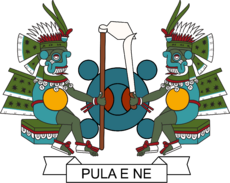User:Bigmoney/Sandbox12: Difference between revisions
Jump to navigation
Jump to search
m (→State parties) |
mNo edit summary |
||
| (4 intermediate revisions by the same user not shown) | |||
| Line 1: | Line 1: | ||
= | =Pulatec Union Legislative Assembly= | ||
{{Infobox | {{Infobox legislature | ||
|name | | name = Pulatec Union Legislative Assembly | ||
| | | native_name = | ||
| | | native_name_lang = | ||
| | | transcription_name = | ||
| | | legislature = | ||
| | | coa_pic = CoAPulacan.png | ||
| | | coa_res = | ||
| | | coa_alt = | ||
| | | coa_caption = | ||
| | | logo_pic = | ||
| | | logo_res = | ||
| | | logo_alt = | ||
| | | logo_caption = | ||
| | | house_type = Tricameral | ||
| | | houses = {{ublist | ||
| | | House of Surveyors (upper house) | ||
| | | House of Delegates (lower house) | ||
| | | ''Ntlo ya dikgosi'' (advisory house) | ||
| | }} | ||
| chambers = | |||
| body = | |||
| jurisdiction = | |||
| term_limits = | |||
| foundation = <!-- {{Start date|YYYY|MM|DD}} --> | |||
| disbanded = <!-- {{End date|YYYY|MM|DD}} --> | |||
| preceded_by = | |||
| succeeded_by = | |||
| new_session = | |||
| leader1_type = Speaker of the House of Delegates | |||
| leader1 = | |||
| leader1_term = | |||
| party1 = | |||
| election1 = | |||
| leader2_type = Chief Surveyor | |||
| leader2 = Tlaloc Xochiquetzal | |||
| party2 = ''Non-partisan'' | |||
| election2 = | |||
| leader2_term = | |||
| leader3_type = Chief Paramount | |||
| leader3 = Kȍhà ǂToma | |||
| party3 = ''xKhasi'' | |||
| election3 = | |||
| leader3_term = | |||
| leader4_type = | |||
| leader4 = | |||
| party4 = | |||
| election4 = | |||
| leader4_term = | |||
| leader5_type = | |||
| leader5 = | |||
| party5 = | |||
| election5 = | |||
| leader5_term = | |||
| leader6_type = | |||
| leader6 = | |||
| party6 = | |||
| election6 = | |||
| leader6_term = | |||
| leader7_type = <!-- up to | leader10_type = --> | |||
| leader7 = <!-- up to | leader10 = --> | |||
| party7 = <!-- up to | party10 = --> | |||
| election7 = <!-- up to | election10 = --> | |||
| leader7_term = <!-- up to | leader10_term = --> | |||
| members = {{ublist | |||
| '''427''' | |||
| 100 (House of Surveyors) | |||
| 327 (House of Delegates)}} | |||
| structure1 = | |||
| structure1_res = | |||
| structure1_alt = | |||
| structure2 = puladelegates.svg | |||
| structure2_res = 210px | |||
| structure2_alt = | |||
| house1 = House of Surveyors | |||
| political_groups1 = | |||
| committees1 = | |||
| house2 = House of Delegates | |||
| political_groups2 = | |||
* {{legend|#173F5F|Nguzo: 96 seats}} | |||
* {{legend|#D40000|Juwa: 79 seats}} | |||
* {{legend|#FEC14E|NJ: 58 seats}} | |||
* {{legend|#000000|LLC: 38 seats}} | |||
* {{legend|#ADD8E6|UH: 27 seats}} | |||
* {{legend|#F1F1F1|Tshiamiso: 20 seats}} | |||
* {{legend|#CD530D|PF: 5 seats}} | |||
* {{legend|#B200FF|Majambazi: 3 seats}} | |||
* {{legend|#18C84C|LPM: 2 seats}} | |||
| committees2 = | |||
| joint_committees = | |||
| term_length = | |||
| authority = | |||
| salary = | |||
| seats1_title = | |||
| seats1 = | |||
| seats2_title = | |||
| seats2 = | |||
| seats3_title = | |||
| seats3 = | |||
| seats4_title = | |||
| seats4 = | |||
| seats5_title = | |||
| seats5 = | |||
| seats6_title = | |||
| seats6 = | |||
| seats7_title = | |||
| seats7 = | |||
| seats8_title = <!-- up to | seats10_title = --> | |||
| seats8 = <!-- up to | seats10 = --> | |||
| voting_system1 = | |||
| voting_system2 = | |||
| first_election1 = | |||
| first_election2 = | |||
| first_election3 = | |||
| last_election1 = | |||
| last_election2 = | |||
| last_election3 = | |||
| next_election1 = | |||
| next_election2 = | |||
| next_election3 = | |||
| redistricting = | |||
| motto = | |||
| session_room = | |||
| session_res = | |||
| session_alt = | |||
| meeting_place = | |||
| session_room2 = | |||
| session_res2 = | |||
| session_alt2 = | |||
| meeting_place2 = | |||
| session_room3 = | |||
| session_res3 = | |||
| session_alt3 = | |||
| meeting_place3 = | |||
| website = <!-- {{URL|www.example.com}} --> | |||
| constitution = | |||
| rules = | |||
| footnotes = | |||
}} | }} | ||

